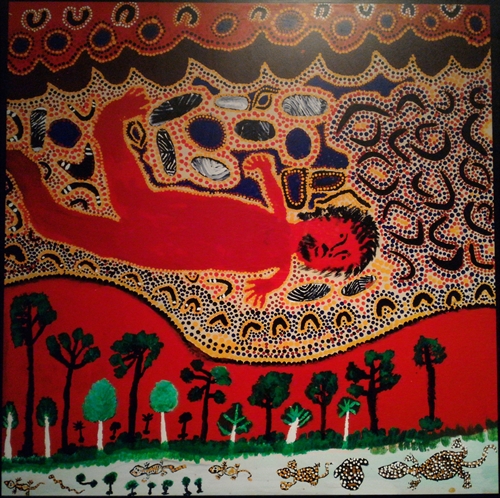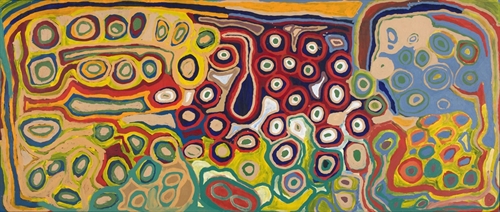 Life & Style
Life & Style

Australian indigenous people are telling their stories through paintings on display for the first time in Việt Nam.
 |
| Stories through art: Kumpupirntily Cannibal Story by Billy Atkins. — VNS Photo Minh Thu |
HÀ NỘI — Australian indigenous people are telling their stories through paintings on display for the first time in Việt Nam.
Titled Canning Stock Route, the exhibition features paintings and portraits by the artists and showcases the process of creation.
The Aboriginals of Australia’s Western Desert lived in their homeland for thousands of years.
In the late 19th and early 20th centuries, the expansion of the Western Australian mining and pastoral industries led to the survey of a track along which cattle could be moved from Kimberley stations to markets in the south.
This track, and the 54 wells that were created alongside it, became known as the Canning Stock Route (Yiwarra Kuju). It was first surveyed by Alfred Canning in the early 1990s.
The route, which runs 1,850km across Western Australia and follows waterholes where animals and people could access drinking water, crosses the boundaries of many Aboriginal language groups.
Similar stock routes were established across aboriginal land throughout Australia.
This is the story of one such track, told from the perspectives of the Aboriginal people whose land it crossed.
It is a story of contact with Europeans, of conflict and survival, of exodus and return. Above all, it is a story of family, culture and country.
The exhibition grew from the Canning Stock Route Project, which brought together 60 artists from different remote communities, who painted their stories of how the stock route changed the lives of their families and ancestors.
“We are very pleased to share a part of Australian history with our Vietnamese friends through this unique exhibition,” Hugh Borrowman, Australian Ambassador to Việt Nam, said.
“Art in general and painting in particular are wonderful tools, not only for passing on stories and exchanging experiences across generations but also as a universal method of communication throughout the world,” he said.
The exhibition is the result of the Việt Nam Museum of Ethnology’s partnership with the Australian Embassy in Việt Nam and the National Museum of Australia.
All the entries are part of a larger exhibition that is underway in Australia.
It features 116 paintings, sculptural works, contemporary cultural objects, documentary materials and oral histories by 60 artists who travelled along the Canning Stock Route on a return-to-country trip in 2007.
Thanks to an innovative idea from the National Museum of Australia, a selection of artworks from the “Canning Stock Route” exhibition was digitised to allow the Vietnamese audience to enjoy these works, while the originals, which are too large to transport to other locations, remain in Australia.
The paintings utilise stories told by the artists, old legends and notes on symbols used by indigenous cultures, helping visitors easily understand not just the painting but also an age-old culture.
The indigenous people live close to the waterholes, which are hallmarks in these paintings.
“The Vietnamese people have the opportunity to explore Australia, its people and its culture,” Võ Quang Trọng, director of the Museum of Ethnology, said.
The exhibition is being held on the occasion of International Museum Day and will run until June 18 at the Việt Nam Museum of Ethnology, Nguyễn Văn Huyên Street, Hà Nội.
In addition to the exhibition, the Museum of Ethnology will also work with the National Museum of Australia to organise a series of workshops on museum management, displaying various techniques and building communication strategies for museums. Staff members from museums across the country will participate. — VNS
 |
| Symbols of the past: An artwork with many symbols representing the land surrounding Canning Stock Route painted by various artists displayed at the exhibition. — VNS Photo Minh Thu |




